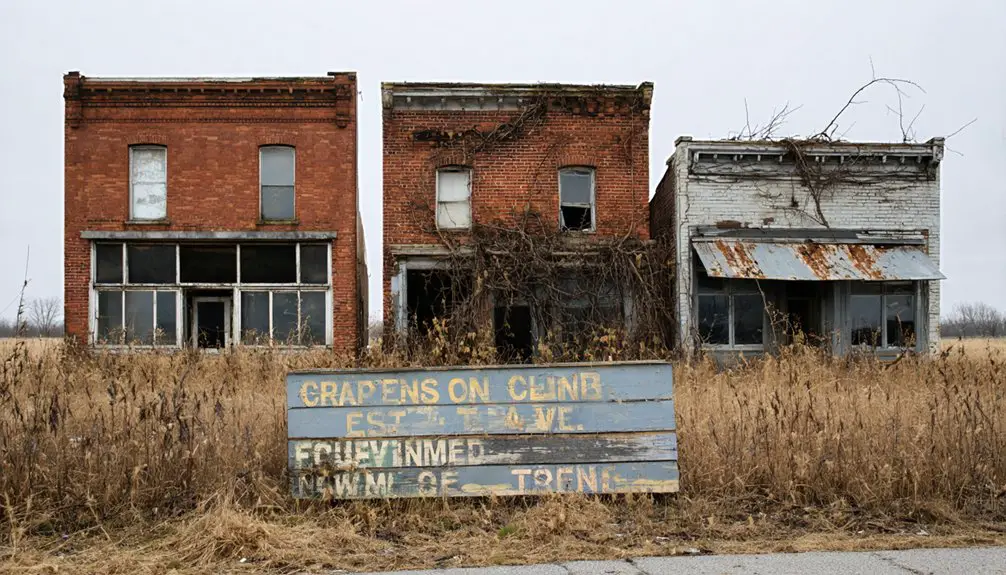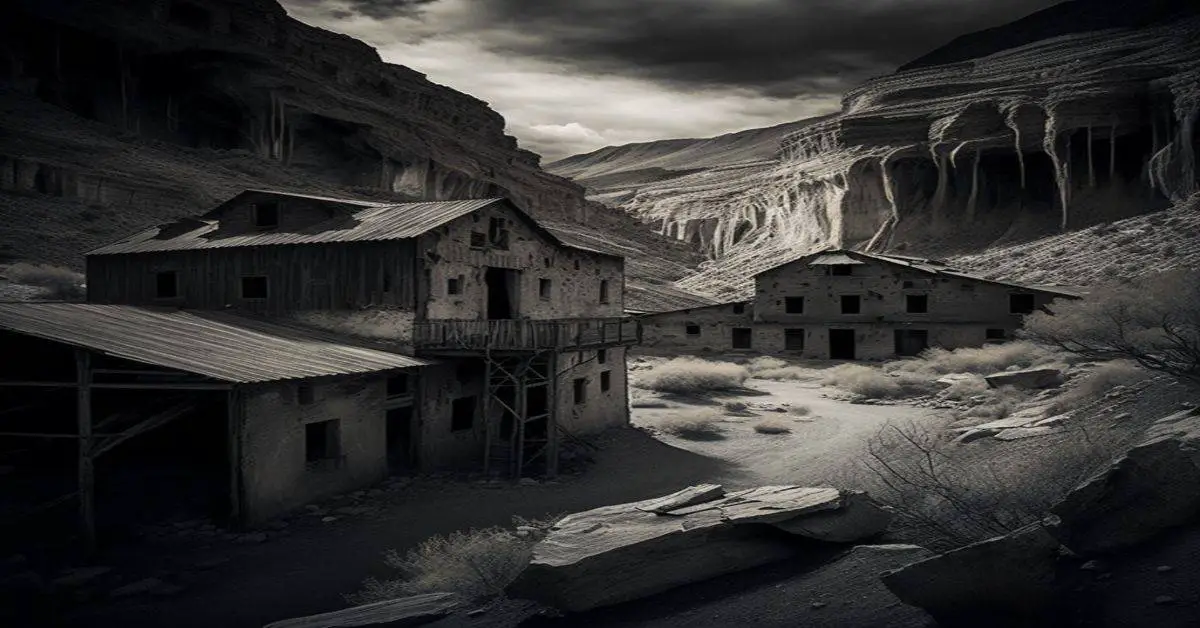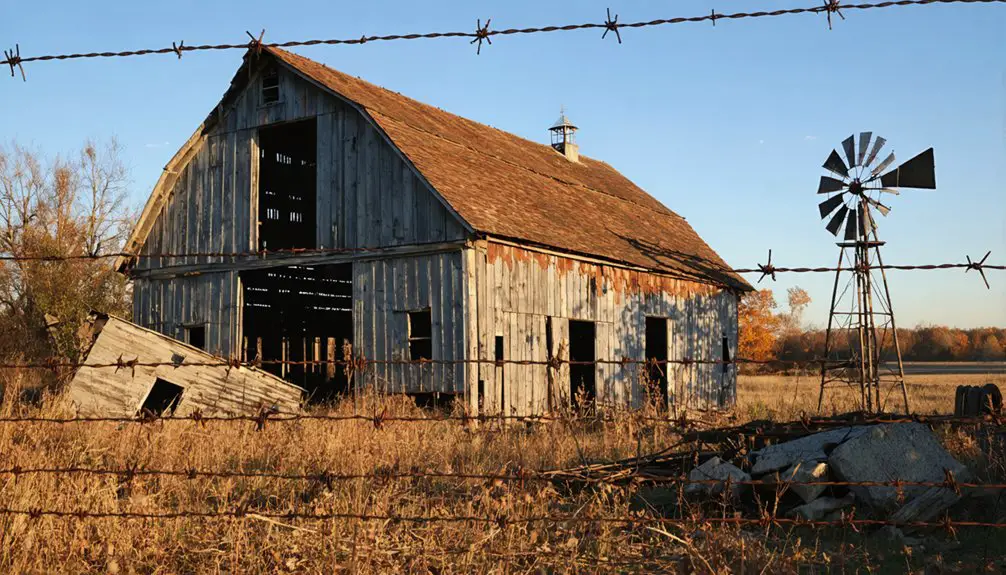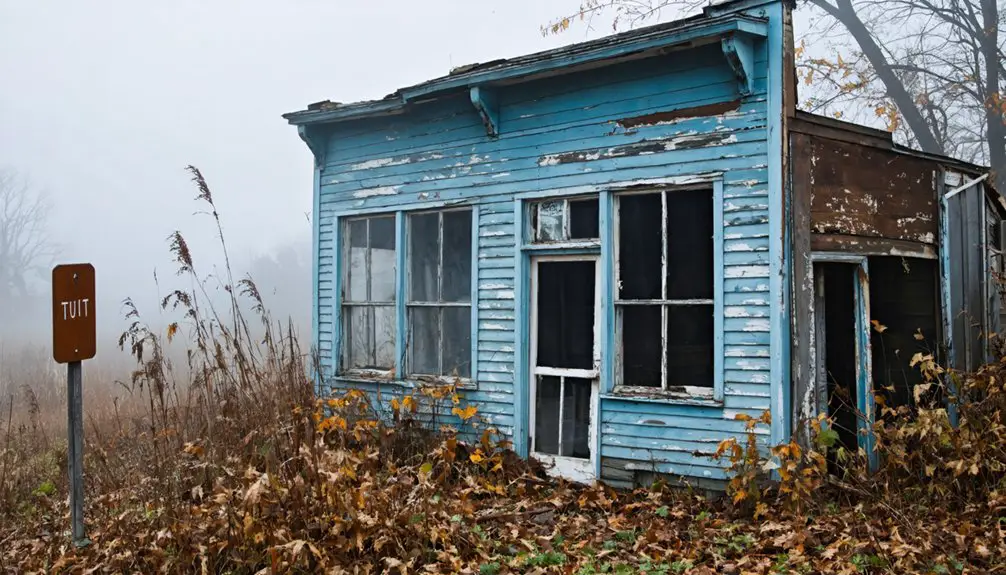You’ll find Blowville’s ruins in southeastern Ohio, where German immigrants established a bustling rural settlement in the mid-1800s. The town thrived with a Methodist church, mills, and general stores until the Baltimore & Ohio Railroad’s route changes eliminated crucial shipping access. By the early 1900s, depleted coal mines and economic decline forced residents to abandon their homes. Today, stone foundations, old railroad trestles, and mysterious tales await those who venture into this forgotten piece of Ohio history.
Key Takeaways
- Blowville was a mid-19th century Ohio settlement primarily populated by German-European immigrants who built wooden frame houses and log cabins.
- The town thrived briefly through agriculture and local industry until railroad route changes eliminated vital shipping access.
- Physical remnants include stone foundations, railroad trestles, tunnel structures, and archaeological evidence of the original settlement’s layout.
- Environmental damage from coal mining operations has created lasting contamination, hampering preservation and restoration efforts.
- The ghost town is known for reported paranormal activity, including spectral figures and unexplained footsteps near abandoned structures.
The Rise and Fall of a Forgotten Settlement
Three critical factors shaped Blowville’s brief existence as an early 19th-century Ohio settlement: its strategic location near essential waterways, its mainly German-European immigrant population, and its ultimate destruction by flooding.
Like many Northwest Territory communities, you’ll find Blowville’s story rooted in strategic positioning and community dynamics. The settlement flourished briefly through agricultural practices typical of Ohio’s expanding frontier, with settlers establishing mills and farms along crucial water routes. Similar to the historic Watts Mill remnants, stone foundations are all that remain of Blowville’s once-bustling riverside industry. The town’s small size was typical of frontier settlements, as even established communities like Moonville never exceeded 100 residents.
The town’s population peaked at several hundred residents, creating a self-sustaining hub for local trade and commerce.
However, nature struck a devastating blow when flooding ravaged the settlement, destroying infrastructure and claiming lives. The disaster triggered a mass exodus, leaving Blowville to fade into obscurity, its remains now hidden beneath decades of overgrowth.
Daily Life in Early Blowville
Before the devastating floods swept away Blowville’s future, daily life in this Ohio settlement revolved around a well-organized community structure.
You’d find families living in wooden frame houses and log cabins, going about their daily chores centered around agriculture and trade. You could visit the local sawmill or gristmill, where farmers brought their timber and grain for processing.
The Methodist church, established in 1840, hosted family gatherings and served as the heart of social life. When you needed supplies, you’d head to the general stores for essentials, while a town physician provided basic medical care. The practice of selling individual plots of land to spiritualist followers was common, drawing new settlers to the growing community. Like many other historical communities in Ohio, Blowville provides a fascinating glimpse into past settlement life.
Economic Forces Behind the Abandonment
You’ll find that Blowville’s fate was sealed by the Baltimore and Ohio Railroad‘s strategic route changes in the early 1900s, which bypassed the town and eliminated essential shipping access for local businesses.
The town’s heavy reliance on coal mining proved unsustainable when the surrounding mines were depleted by 1920, forcing many workers to seek employment elsewhere. Similar to Ingham Station, where the mine closed down in 1909, the loss of mining operations had devastating effects on the local economy.
These combined factors triggered a rapid exodus of residents, with families abandoning their homes as both transportation and employment opportunities vanished from the once-thriving community. The decline mirrored the pattern seen in Moonville, where the B&O Railroad acquisition marked the beginning of the town’s demise.
Railroad Route Changes Impact
As railroad companies consolidated their operations in the late 19th century, Blowville’s position on the Cincinnati & Eastern Railroad line became increasingly precarious.
The town’s railroad history shifted dramatically when Norfolk & Western Railway absorbed the line, leading to significant transportation evolution that would ultimately seal Blowville’s fate. The merger of Ohio & West Virginia Railway and Columbus & Hocking Valley formed the Columbus, Hocking Valley & Toledo in 1881, drawing traffic away from smaller lines.
- Competing railroads, especially the Baltimore & Ohio, drew traffic away from Blowville’s routes.
- Management conflicts between rail companies disrupted efficient transfers and service agreements.
- Changes in freight patterns, particularly coal and lumber shipments, reduced the line’s profitability.
- Flood damage along the Ohio River provided companies with justification to abandon less profitable segments.
These route changes dealt a severe blow to Blowville’s economy, as the town lost essential connections to regional markets and commercial opportunities that had sustained its growth.
Similar to Cleveland Eastern Railway’s decline, ridership dropped dramatically as rising transportation fares made rail travel less economically viable for local residents.
Resource Depletion Drives Exodus
While coal mining fueled Blowville’s growth from 1850 to the 1920s, the town’s fate hinged on the finite nature of its mineral resources.
You’d have witnessed Ohio’s coal production surge from 1 million to 40 million tons annually during this period, creating a boom economy that couldn’t last.
As local coal seams became depleted, poor resource management led to the mines’ inevitable closure.
You’ll find that this triggered a devastating chain reaction: jobs vanished, businesses folded, and tax revenues plummeted.
The resulting population migration left Blowville’s infrastructure abandoned and its property values in freefall.
Acid mine drainage from abandoned mines stained local waterways a rusty orange color, making the area increasingly uninhabitable, while the lack of economic diversification meant there wasn’t anything left to keep residents in town. Like many of the 70 mining towns that once thrived in southeast Ohio, Blowville succumbed to economic pressures and environmental decline.
Physical Remnants and Archaeological Findings
You’ll find weathered stone foundations scattered throughout Blowville’s original settlement area, particularly near the former riverbanks where communal structures once stood.
The remnants include foundational stones from the town’s general stores, post offices, and schools, though many are now hidden beneath decades of soil and vegetation.
Infrastructure discoveries have revealed old railroad trestles and tunnel structures that marked essential transportation routes through the settlement, with scattered rail hardware and lanterns still occasionally surfacing near these ruins.
Foundations and Building Remnants
Today’s visitors to Blowville will find scattered stone and brick foundations partially buried along the riverbanks, providing essential clues to the town’s original layout.
Foundation analysis reveals evidence of communal buildings raised on sturdy stone bases, while archaeological preservation efforts have documented numerous cellar pits and wall segments throughout the site.
- Stone foundations of the town’s prominent structures remain visible near old river curves, though many are now hidden under thick vegetation.
- Wall-trench structures and post-set buildings in shallow basins indicate varied construction techniques used by early settlers.
- Natural floods have damaged some riverbank foundations, but their remnants still outline the settlement’s footprint.
- Cemetery sites near building foundations offer additional context for understanding Blowville’s historical significance.
Lost Infrastructure Discoveries
Archaeological excavations have revealed extensive infrastructure remnants throughout Blowville’s former township boundaries.
You’ll find the most significant lost artifacts along the old Cincinnati & Eastern Railroad path, where electric poles and bridge foundations mark the transport route that once connected Blowville to regional commerce.
The community’s resilience is evident in preserved structures like Union Township School No. 5‘s foundation on Beechwood Road and burial sites at Greenmound Cemetery.
Beneath layers of soil and vegetation, you can trace Blowville’s layout through buried house foundations and farm building remains.
The town’s infrastructure legacy lives on at the former Beechwood station site, positioned between the Ragland and Davis properties, where railroad remnants still tell the story of this vanished community.
Local Legends and Ghostly Tales
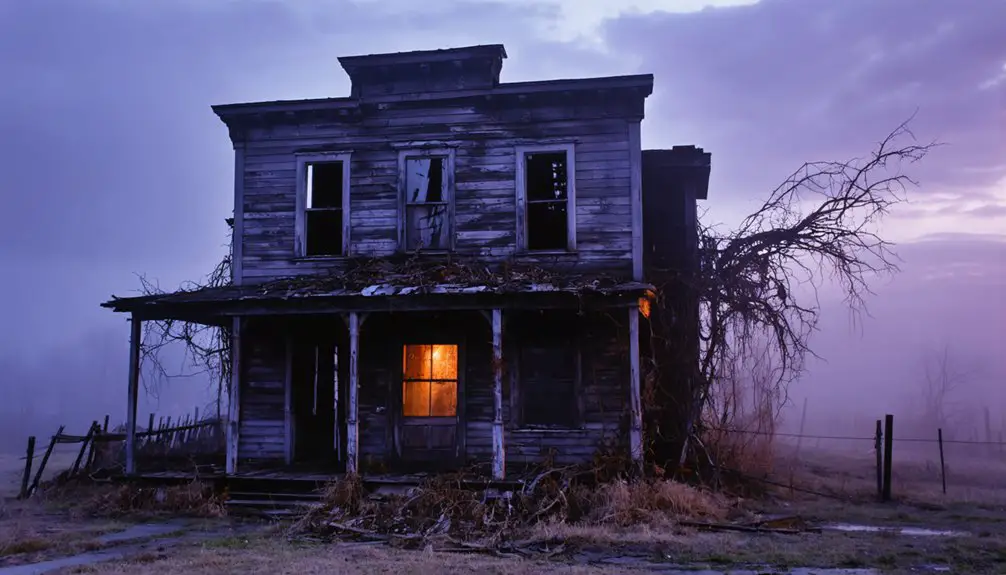
While many ghost towns harbor their share of spooky tales, Blowville’s supernatural legends run uniquely deep through its history, stemming from documented tragedies and unexplained phenomena that have captivated locals since the town’s decline.
The ghostly apparitions you’ll encounter often connect to the town’s historical tragedies, with haunting legends of former residents still lingering near abandoned structures and derelict buildings.
Spectral figures of long-departed townspeople drift through crumbling ruins, their tragic stories forever bound to these forsaken places.
These spectral encounters, validated by paranormal investigators and local witnesses, have their folklore origins in catastrophic events like fires, epidemics, and mining accidents.
- Misty figures in period clothing appear near the town’s historic residences
- Disembodied footsteps and whispers echo through former public buildings
- A protective “founder’s ghost” is said to watch over specific landmarks
- Local paranormal hot spots align with documented town tragedies
Environmental Impact on Town Preservation
Beyond the supernatural tales that haunt Blowville’s remains, environmental devastation has played a defining role in the town’s preservation status.
The town’s proximity to coal operations, particularly plants like Gavin, left an indelible pollution legacy that’s made restoration nearly impossible. You’ll find extensive soil contamination throughout the area, while toxic runoff continues to poison local waterways.
The environmental degradation extends beyond mere aesthetics – it’s created an uninhabitable zone where wildlife struggles to survive.
Native plant species can’t recolonize the contaminated soil, and the town’s infrastructure crumbles amid the toxic conditions.
The combined impact of water pollution and soil erosion has effectively sealed Blowville’s fate, as cleanup costs and health risks deter any serious attempts at revitalization.
Historical Significance in Ohio’s Rural Development
During the mid-19th century, Blowville emerged as a quintessential example of Ohio’s rural development, anchored by its strategic position along the Cincinnati & Eastern Railroad.
The town’s social dynamics reflected the era’s commitment to community-building, with architectural styles typical of frontier settlements shaping its identity.
Frontier architecture and social bonds wove together the fabric of small-town life in America’s expanding heartland.
- A Methodist church served as the town’s spiritual and social cornerstone, drawing residents together for worship and community gatherings.
- Local mills processed agricultural products, connecting farmers to wider markets through the railroad.
- The general store and blacksmith shop formed a commercial hub that supported regional agricultural operations.
- A one-room schoolhouse provided education, demonstrating the town’s investment in future generations.
You’ll find that Blowville’s story mirrors many Ohio settlements where transportation, agriculture, and community institutions converged to shape rural life.
Frequently Asked Questions
Are There Any Surviving Photographs of Blowville During Its Peak Years?
You won’t find any confirmed photographic evidence in historical archives showing peak-era views, though private collections of founding families might hold undiscovered images from the town’s railroad and farming days.
What Happened to the Town’s Cemetery and Burial Records?
Among hundreds of lost rural cemeteries in Ohio, you’ll find this one’s records vanished as the town emptied. The burial grounds, roughly 1/4 mile from Binning Road, lost all maintenance and documentation over time.
Did Any Notable Historical Figures Ever Visit or Live in Blowville?
You won’t find any documented famous visitors or historical impact makers in town records. There’s no evidence of notable figures ever living in or passing through this particular location.
Were There Any Documented Native American Settlements in the Blowville Area?
Like GPS coordinates from the past, Native tribes left their mark here – Wyandot camps existed until 1807, and Raccoon Town thrived nearby until settlers Charles and George Green claimed the land.
What Modern Properties or Landmarks Now Exist at Blowville’s Former Location?
You’ll find farmland and residential areas of Summerside where abandoned structures once stood. Modern developments include the Greenberry Memorial Masonic Temple, while nearby cemeteries preserve the area’s heritage.
References
- https://www.youtube.com/watch?v=QWTtG6njIDs
- https://ohioghosttowns.org/top-10-ghost-towns/
- https://www.youtube.com/watch?v=XVwj5wpsgTM
- http://freepages.rootsweb.com/~gtusa/history/usa/oh.htm
- https://wrkr.com/ohio-ghost-towns/
- https://visitvintoncounty.org/the-legend-of-moonville/
- https://ohioghosttowns.org/top-10-town-tales/
- https://kids.kiddle.co/List_of_ghost_towns_in_Ohio
- https://ohioghosttowns.org/clermont-county/
- https://en.wikipedia.org/wiki/List_of_ghost_towns_in_Ohio
